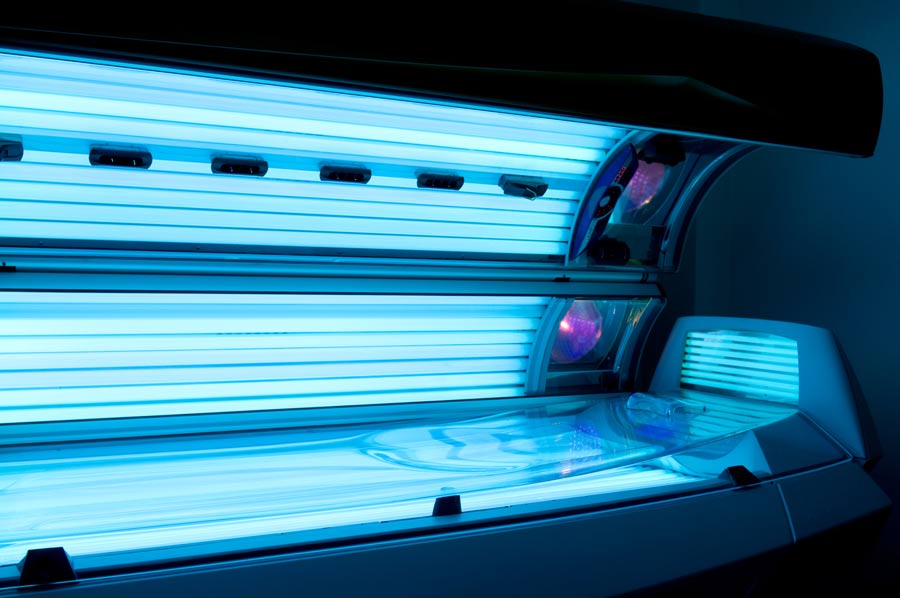Selling people on the benefits of indoor tanning seemed like a great way to make money when Nicole Calo was a teen — until she went to work for dermatologist Deborah S. Sarnoff, MD, and learned how dangerous and even deadly tanning can be. Now 24, she shares a peek inside the tanning world and why she’s glad she’s seen the light.
What’s your tanning history?
I was born in Brooklyn, then moved to Queens, then to Long Island. Our family spent summers at the pool and beachside. I have a light skin tone, blonde hair and blue eyes, so initially I would burn and then get freckly. As a teen, I did some indoor tanning at other times of the year. To be honest, I felt like when you’re tan, you just have that glow. You’re ready to go out and have fun.
At 16, you started working for a popular tanning salon that had numerous locations. Did that increase the pressure on you to be tan?
Yes, if you were an employee there, you had to be tanned, pretty, dressed up and with perfect makeup. Tanning was free for employees. I thought it was a quick and convenient way to get a dose of color. I knew it had some risks, but I didn’t realize at that time how bad indoor tanning is for you. And neither did the other girls.
Who were your customers?
My friends came in to tan before sweet 16 parties, high school dances, all that stuff. A lot of my customers who tanned regularly were women ages 21 to 26. They would have a date and wanted to look good for the night. I’d just say, “Why not buy this package of 25 sessions for $1,000,” and they would do it. There’s a lot of money on that part of Long Island, and people could afford it.
“Tanning was free for employees. I knew it had some risks, but I didn’t realize at that time how bad indoor tanning is for you.”
As a sales associate, how did you motivate customers to become tanning regulars?
I was on commission, so the more we sold, the more money we made. On the computer system we would see each store’s sales average and see our names listed. It was a hot competition to sell more. We all wanted to be the best. We sold packages with several levels. The highest, most expensive levels offered different machines that supposedly had bulbs that provided quicker, better browning and less reddening. One machine at the top level is similar to a lounge chair; you just lie on top of it. Or you could stand up, so your body wouldn’t have to touch anything. There was even a machine just to tan your face.
People liked the whole tanning experience. It was very spa-like. When you come in, you’re greeted with smiles and you’re treated like a prince or a princess. You’re given a towel and lotion and at some levels they would spritz you with water and a coconut scent. You’re relaxed, warm and at ease.
Were there many rules and regulations?
Customers were only supposed to tan for 10 to 12 minutes. But the girls working in sales controlled the time. If the customers said, “I’ll spend more money if you put me in the bed for 15 minutes,” the girls would do it, and their sales and commissions would go up. We sold unlimited packages, and customers would go to two different locations to tan the same day. If a child under 16 wanted to come in and tan, we were supposed to get parental consent and have the parent sign a form at the front desk with the sales associate, but there wasn’t a lot of enforcement.

Although Nicole (right) previously worked at another dermatology office, she says, “I learned so much more about the dangers of tanning from Dr. Sarnoff (left, in her Long Island office). As the president of The Skin Cancer Foundation, she really knows her facts!”
How did you end up working for a dermatologist?
I had been working part time as a nanny for a family while going to school at night, and one day the father asked if I wanted to come work in his dermatology office. When I did, I started to learn about the dangers of tanning. When I moved to Dr. Sarnoff’s office, I saw so many skin cancer patients who were former tanners coming in to have surgery. Seeing the wounds, the bandages, the things that they go through, I realized, the proof is in the pudding. I thought, “Oh, my goodness, I do not want to have that happen to me.”
What are your sun habits now?
I am so OCD about it! I no longer do indoor tanning, of course. I apply sunscreen on my face and my body every day. I always wear sunglasses. I wear a hat when I can. I never lay out in the sun anymore. And now I tell people, really coming from the heart, “Do your research, and don’t believe everything you hear. Tanning is not what it seems.”

*This article was first published in the 2018 issue of The Skin Cancer Foundation Journal.





